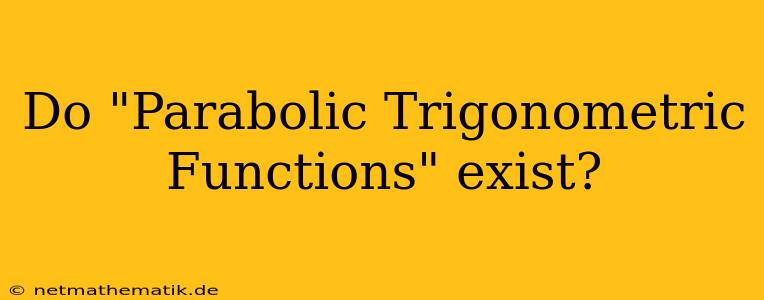The question of whether "parabolic trigonometric functions" exist is an intriguing one, inviting us to explore the fascinating interplay between trigonometric functions and parabolic curves. While the term "parabolic trigonometric function" isn't a standard mathematical term, the concept it suggests sparks interesting avenues of inquiry. This article will delve into the meaning and significance of both parabolic curves and trigonometric functions, examining potential connections and exploring why a direct analogue of "parabolic trigonometric functions" might not exist in the same way that we have trigonometric functions for circles.
Understanding Parabolic Curves
A parabola is a fundamental geometric shape defined as the set of all points that are equidistant to a fixed point called the focus and a fixed line called the directrix. This simple definition leads to a rich mathematical description involving quadratic equations. The most familiar form of a parabola is the graph of the equation y = x², a symmetrical curve opening upwards.
Parabolic curves are ubiquitous in nature and technology. They describe the path of projectiles in a uniform gravitational field, the shape of satellite dishes, and the reflection of light in a parabolic mirror. This ubiquity is due to the unique property of parabolas: they reflect all rays parallel to their axis of symmetry to the focus.
Exploring Trigonometric Functions
Trigonometric functions, such as sine, cosine, and tangent, are fundamentally connected to the circle. They describe relationships between angles and the sides of right triangles inscribed within a unit circle. These functions have periodic properties, meaning they repeat their values at regular intervals. They are essential tools in fields ranging from calculus and physics to engineering and music.
Why "Parabolic Trigonometric Functions" Might Not Exist
While the concept of "parabolic trigonometric functions" is intriguing, it faces fundamental challenges:
- Lack of a Natural Unit: Trigonometric functions are defined with respect to a unit circle, providing a natural scale for measuring angles and ratios. Parabolic curves, on the other hand, lack such a natural unit. The relationship between angles and distances along a parabola is more complex and less intuitive.
- Periodicity: Trigonometric functions exhibit periodicity, a property crucial for their applications. However, parabolas don't naturally possess periodic properties. The curvature of a parabola changes continuously, and there's no inherent repeating pattern as seen in circles.
- Angle Measurement: Angles are conventionally defined within a circular context. Measuring angles along a parabola presents challenges. The concept of "angle" along a parabolic arc requires redefinition and potentially introduces complications in terms of consistent measurement.
Potential Analogues and Extensions
Despite the lack of direct "parabolic trigonometric functions," several mathematical concepts can be explored to understand the relationship between parabolas and trigonometric functions:
- Parametric Equations: Parabolic curves can be described using parametric equations. These equations can involve trigonometric functions, offering a way to represent parabolic motion in terms of angles and time. However, these are not direct analogies to trigonometric functions as they are not tied to the inherent properties of the parabola itself.
- Generalized Trigonometric Functions: Mathematicians have explored generalizations of trigonometric functions beyond the circle. Elliptic functions, for instance, are generalizations of trigonometric functions related to ellipses. However, developing analogous functions specifically for parabolas remains an open area of research.
- Harmonic Analysis: Harmonic analysis involves decomposing functions into a sum of simpler functions, often using trigonometric functions. This approach could be extended to analyze and approximate functions defined on parabolic curves, but it wouldn't necessarily create new functions directly analogous to "parabolic trigonometric functions."
Conclusion
The question of whether "parabolic trigonometric functions" exist is a thought-provoking one. While a direct analogy to circular trigonometric functions doesn't exist, the exploration of this concept leads to insights into the nature of both parabolas and trigonometric functions. The lack of a natural unit, the absence of periodicity, and the challenges in defining angles along a parabola pose fundamental obstacles. However, alternative approaches using parametric equations, generalized trigonometric functions, and harmonic analysis offer potential avenues for exploring relationships between parabolas and trigonometry, furthering our understanding of these fundamental mathematical concepts.
